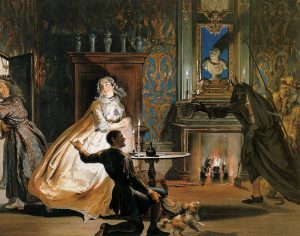Mysteries of Gilt Leather
This famous phrase from William Shakespeare’s play The Merchant of Venice (1596-1599) does definitely applies to gilt leather. Most gilt leather does not hold even a trace of gold. The metal-leaf which has been applied in almost all gilt leather dating from the 16th to the 18th centuries is actually silver. Covered by a yellowish oil-resinous varnish this gave the leather its ‘golden’ appearance, hence gilt leather.
The phrase ‘All that glitters is not gold’ has equivalents in several other languages: ‘Het is al geen goud wat er blinkt’ (Dutch), ‘Es ist nicht alles Gold, was glänzt’ (German), ‘Tout ce qui brille n’est pas d’or’ (French), ‘Non è tutto oro quel che luccica’ (Italian), ‘Allt är inte guld som glimmar’ (Swedish), ‘No todo lo que brilla es oro’ (Spanish), and amongst others also in Polish: ‘Nie wszystko złoto, co się świeci’.
Spanish leather / Cuir de Cordoue / Mechels goudleer / Kurdybanu
Gilt leather is referred to in various countries with different names and words. Some of these are quite misleading, such as the English ‘Spanish leather’, the French ‘Cuir de Cordoue’, the Flemish ‘Mechels goudleer’, and the Polish ‘Kurdybanu’’. Although gilt leather originated from Spain, these generic terms can give the misleading suggestion that all gilt leather was made in resp. Spain, Mechelen and Cordoba. Nothing less is true! These terms have caused confusion and has led to many misattributions. Gilt leather has been made ages over the centuries in various production centres, scattered all over Europe.
As a result, several (old) references are quite deceptive. A good example for this is Karl Baedekers Guidebook to Belgium and Holland (1894), in which one of the rooms in Museum Plantijn-Moretus in Antwerp is described as ‘… the so-called Room of Justus Lipsius, with Spanish leather hangings, …’. This specific gilt leather wall hanging -which still exists-, has without doubt been produced in the Netherlands.
The most well-known gilt leather room has been overpainted
Overpainting of works of art and historical objects is widely considered as undesirable and even as a serious depreciation of those objects. Beyond doubt this also counts for gilt leather. In many, if not almost all cases new paint- and varnish-layers on gilt leather have disastrous effects. Complete overpainting is from the point of view of conservation ethics beyond all discussions. Paradoxically by far the most famous gilt leather room in the world is known for its highly appreciated overpainting.
In 1876-77 the well-known British artist James McNeill Whistler (1834-1903) completely overpainted the late 18th century gilt leather wall hanging in the dining room of 49 Princes Gate, London. Whistler was authorised by the owner of the house, the shipping magnate Frederick Richards Leyland, to retouch with yellow paint the red flowers adorning the leather wall hanging. During the absence of his patron Whistler continued working on it:
Well, you know, I just painted on. I went on -without design or sketch- it grew as I painted. And toward the end I reached such a point of perfection -putting in every touch with such freedom- that when I came round to the corner where I started, why, I had to paint part of it over again, as the difference would have been too marked. And the harmony in blue and gold developing, you know, I forgot everything in my joy in it.
Upon returning Leyland was furious and completely shocked by Whistlers’ ‘improvements’. This resulted in a quarrel over both the room and a proper compensation for the work done, and ended their relationship. During the subsequent absence of Leyland, Whistler gained access again to his house. On top of the gilt leather hanging he painted two enormous fighting peacocks, representing the artist and his patron. Since then the room is known as ‘The Peacock Room’. The entire room was sold off by Leyland’s heirs in 1904, and since 1920 the Peacock Room is permanently installed in the Freer Gallery of Art in Washington D.C.
Sources:
https://en.wikipedia.org/wiki/The_Peacock_Room
http://peacockroom.wayne.edu/
L. Merrill, The Peacock Room: A Cultural Biography. Washington 1998

A gilt leather pettycoat
One of the most extraordinary uses of gilt leather can be found on the effigy of the English Queen Mary II Stuart (1662-1694). Believe it or not, underneath her precious gown she wears a gilt leather petticoat. Its pattern is not less amazing: it is a chinoiserie-pattern, identical to the silk hangings of the state bed at Milton House. This petticoat was special made for this effigy, March 1, 1725, the invoice of £ 5 was paid for it.